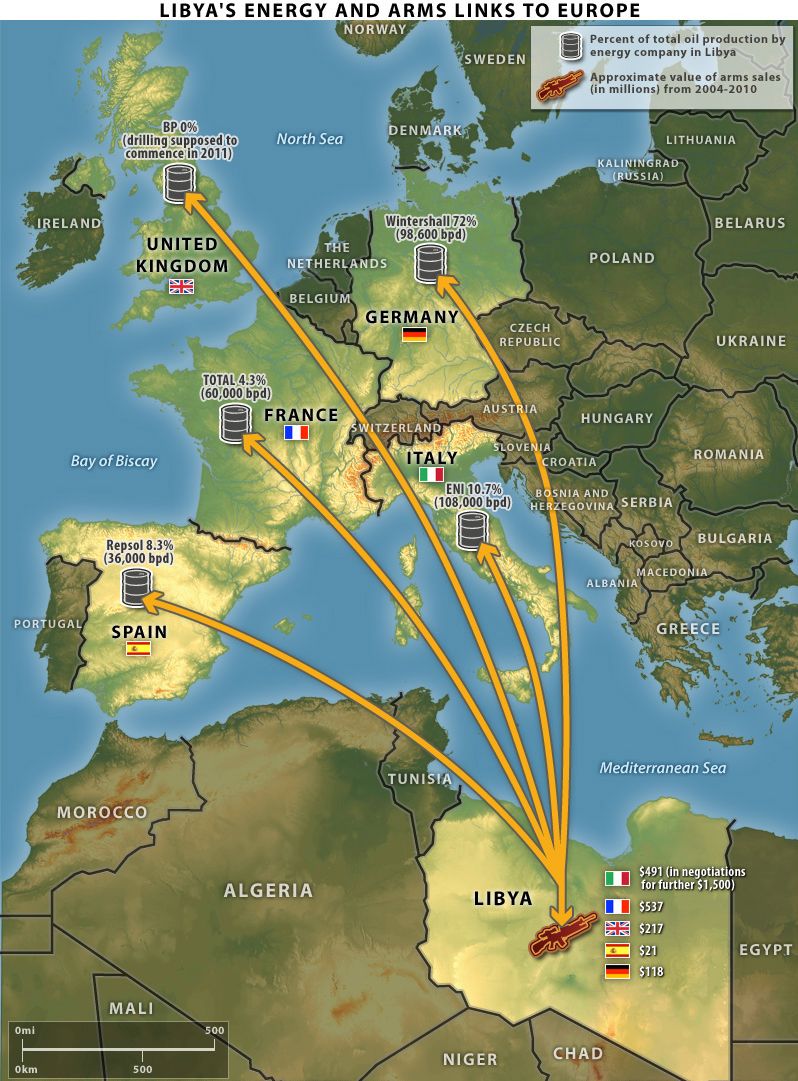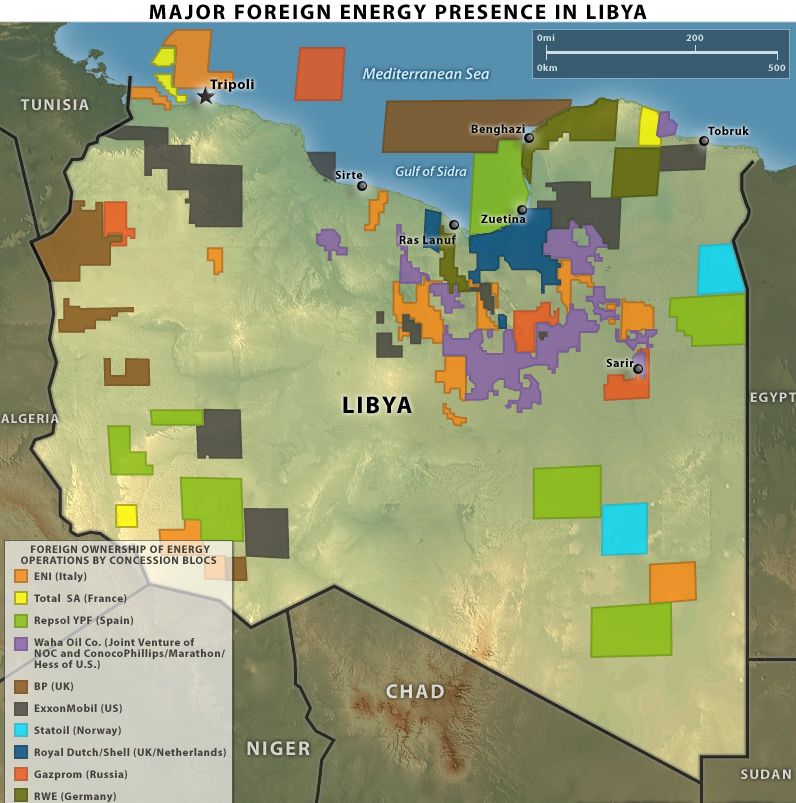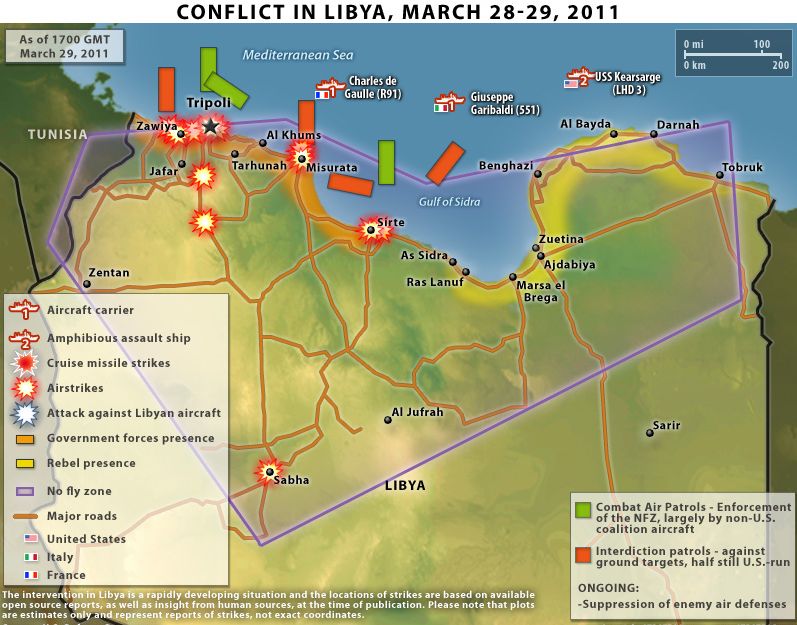Because Italy has far more to lose than
anyone else involved in the U.S.-European coalition, Italy sought to hedge its
policy toward Gadhafi throughout the run-up to the
intervention. Rome initially took a line very close
to that of Tripoli, with Italian Foreign Minister Franco Frattini
voicing concerns Feb. 21 over the “self-proclamation
of the so-called Islamic Emirate of Benghazi” echoing a statement from Gadhafi’s son, Seif al-Islam,
issued the previous day to describe the rebels in eastern Libya.
While
Italy now supports the coalition against Gadhafi,
offering the use of seven Italian airbases to coalition aircraft and having the
Italian air force conduct patrols over Libyan airspace,
Rome continues to hedge its policy. Frattini on March
21 said Italy would have to resume control of its airbases, thus hinting it
would kick out foreign troops, if some sort of NATO coordination structure were
not agreed upon. Rome’s insistence that it is both part of the intervention and
has abstained from playing an aggressive role against Gadhafi
is a strategy intended to allow Italy to continue to balance the rebels in the
east with Gadhafi in the west of the country. Rome
simply has too many interests in Libya to pick one side and stick with it.
NATO
command-and-control structures are important to Rome, which does not want the
Libyan intervention to remain a Paris-London affair when the United States
withdraws from leading the operations, leaving Italy’s energy and security
interests at the mercy of two countries looking to gain the upper hand in a
post-Gadhafi Libya.
This
explains Rome’s reluctance to allow France to lead a command structure
concurrent with NATO’s. Rome simply does not trust Paris or London, both of
whom have plenty of reasons to expand energy and business interests once rebels
grateful to both for leading the charge in Libya assume power in the eastern
part of the country. Rebel leaders themselves have stressed that economic ties
“will be calibrated to reflect the support that the various European countries
have offered the grasroots uprising,” as the Libyan
National Transition Council Deputy Chairman Hafiz al-Ghogha
said in a response to a question what is in store in the future for Italy’s
business and energy interests in Libya. In fact, one can directly draw a
parallel between the competing interests of Italy, France and the United
Kingdom in the intervention in Libya today with the competing interests of the
three during the colonial 19th-century Scramble for Africa.
Geographically,
Italy is one of the closest European country to Libya,
with the island of Lampedusa, a destination of choice
for migrants fleeing North African unrest, only 225 kilometers (140 miles) from
Libya. It shares deeper ties with Libya than the rest of Europe, given its
former colonial relationship. Like Germany, Italy became a unified European
power only in the late 19th century and entered the scramble for African
colonies after France and the United Kingdom had taken the choicest spots. The
desolate stretch of North Africa just south of Sicily was still available, so
Italy began building a sphere of influence in what is now Libya but was then
three separate states: Tripolitania, Cyrenaica and Fezzan. Italy invaded in
1911, but resistance by insurgents in Cyrenaica (today’s eastern Libya) lasted
until the 1930s. Italy lost its North African colony after World War II.

Because
of its geographic proximity and knowledge of local conditions, Italy has not
shied from conducting business in Libya in the post-World War II era. Energy company ENI began operating there in 1959 and never left the
country, even when the rest of the West rebuffed Gadhafi
in the 1980s due to his association with terrorism. This commitment to Libya
allowed Rome to negotiate lucrative energy and arms contracts once Gadhafi renounced terrorism in 2003. Today, Libya accounts
for some 15 percent of ENI’s total global hydrocarbons output, with oil
production of 108,000 barrels per day and natural gas production of 8.1 billion
cubic meters in 2009.
Italy
has also been one of Gadhafi’s major arms suppliers
since an EU arms embargo was lifted in 2004, a step for which Italy strongly
lobbied. Italy has delivered on approximately $500 million worth of deals since
2004, slightly less than the value of French military deliveries.

The
flow of capital and investments is not one-sided; Libya’s sovereign wealth fund
has invested in a number of Italian financial and industrial enterprises.
Libya’s sovereign wealth fund owns about 1 percent of ENI, and had stated its
intent to increase its stake to 10 percent; 7.2 percent of UniCredit,
Italy’s biggest bank; and 2 percent of weapons manufacturer Finmeccanica.
Rome fears Gadhafi could withdraw these investments
from Italy — something Gadhafi has threatened — or
that a new government in Libya might decide to invest in Paris and London
instead.
Acceptable
Exit Strategies?
Italy
has therefore enjoyed a privileged relationship with Gadhafi,
from energy to weapons sales to its being a main destination for Gadhafi’s investments. The cozy business relationship has
allowed Rome to negotiate a deal on securing its seas from an unchecked influx
of migrants, both a national security and domestic political issue. Since
January, when the Tunisian upheaval kicked off the unrest in the Arab world,
19,000 migrants — including 2,000 Somalis and Ethiopians — have landed on Lampedusa. This has largely confirmed Rome’s fears that the
general unrest in North Africa — combined with the destabilization of Libya —
would lead to an exodus of North and sub-Saharan Africans to Italy.

The
current situation carries many risks for Italy. Replacing Gadhafi
with an unknown regime or unstable environment that resembles the tribal warlordism of Somalia would lead to unchecked migration
flows — which is essentially already happening — and an insecure business
environment. His replacement with a rebel leadership grateful to London and
Paris but suspicious of Rome also would threaten Italian interests. But
participating in the coalition is risky, too, as Gadhafi
could wind up clinging to power and deciding to seek revenge against Italy for
joining forces with the United States, France and United Kingdom against him
despite the 2008 friendship treaty.
Moreover,
the European coalition allies do not trust each other. Rome believes that
London and Paris are undermining Italy’s long-held upper hand in Libya. Italy
wants to ensure its influence in how a post-intervention Libya is run and therefore
has fought to move the coalition toward a NATO command-and-control structure
that would be headquartered in Naples — allowing Rome to keep a close eye on
the operations’ details.
Because
its European neighbors seem unwilling to deal the finishing blows to the Gadhafi regime — at least as of this moment — Rome must
take into account the possibility that Gadhafi could
remain in power, if only in the western portion of Libya. Italy is therefore
walking a tightrope: It can stand neither with Gadhafi
nor too aggressively against him. Rome therefore has to be part of the
coalition so as not to be frozen out of Libya by a new regime in the event Gadhafi is eliminated; however, its participation in the
coalition has to be conducted in a halting manner to minimize the risks to its
energy assets in western Libya should Gadhafi
survive.
Rome
is jockeying to play the role of peacemaker by participating in the coalition
while not seeming overly eager to oust Gadhafi,
currying favor with both the coalition and Gadhafi.
To this end, Italy has sought, and has received, command over the NATO naval
operation to embargo Tripoli’s access to arms, potentially a beneficial command
if Rome wants to have power over Gadhafi in the near
future. It has in the meantime maintained a non-aggressive role in the
intervention so that it can claim to Gadhafi that its
intentions from the beginning were to be a voice of reason in the intervention.
Rome will attempt to use both its links to the Gadhafi
regime and its role in the intervention to carve out a post-conflict mediator
role that can protect its interests.
The
problem with Italy’s plan is both the fluidity of the situation and the fact
that it’s ability to
continue hedging its role is being reduced every day London and Paris endear
themselves to the rebels and as Gadhafi becomes more
indignant toward Western powers. Ultimately, it is difficult to see Italy being
completely frozen out of Libya. Geographic proximity and a long history of
involvement means Rome, from Carthage to Libya, always
has had a hand in the affairs of North Africa. The question in Rome today is
how profitable that influence will be.
Today’s Question of
Arming the Rebels
The
problem the coalition forces seem to have today is that there is a gap between
what they said they want to do to get rid of Gadhafi
and what the no-fly zone authorizes them to do, which is use military force to
protect civilians. And they are considering to close
that gap by strengthening the opposition. Strengthening the opposition by giving
them arms, so they can impose their own anti-tank and -- and anti-air zone.
Another consideration here will be that a partitioned Libya is not what they
are looking for as an end state. Today the rebels have already been beaten back
to Ras Lanuf, which they
had moved through quickly just yesterday.

As expected
thus the airstrikes are not effective in the sense that Gadhafi
now even is able to move from the defensive to the offense. There
are still a great deal of questions as to who is
involved in the rebel group as the situation is still very fluid at
this point.
Coalition
airpower is capable of defeating Gadhafi’s air force,
crushing his larger, more fixed air defense capabilities as well as taking out
known command, control and communications hubs. But the use of airpower to
eliminate Gadhafi’s ability to wage war would entail
civilian casualties and collateral damage. While airpower is the wrong tool for
the job, no country is willing to provide the right tool in the form of ground
combat forces. Thus providing weapons to the Libyan rebels is increasingly
appearing to be the best alternative, at least to some of the coalition
partners. In theory, this would provide the capability to do what airpower
cannot and enable the rebels to provide the required ground presence. However,
at no point in the Libyan civil war have the rebel fighters proved to be a
competent military force, and their difficulties are not solely linked to their
lack of arms. And without coherent organization, leadership, battlefield
communications or command and control, as well as the ability to plan and
sustain offensives logistically, no quantity of arms is going to solve the
problem.
In
the early days of unrest, opposition forces broke open Libyan military arsenals
and appropriated an enormous quantity of small arms, ammunition, heavy weapons
and related materiel, including armored vehicles and rocket artillery. Numerous
reports have described rebels expending massive amount of ammunition to no
purpose, firing small arms, rockets and recoilless rifles aimlessly into the
air. Early on there were reports that a rebel SA-7 shoulder-fired
surface-to-air missile was used to shoot down one of the rebels’ own planes,
and the rebels have even implicitly acknowledged their limitations by issuing a
call for drivers capable of operating a T-55, an archaic Soviet tank and one of
the oldest in even the Libyan arsenal.
Indeed,
the longer-term problem in Libya might be not too few arms, but too many. All
of the arms that have been broken out of Libyan stockpiles will not be returned
after the conflict ends. Everything from small arms to explosives to
man-portable air defense systems (MANPADS) will be proliferating around the
region for years. There are also minor concerns that even within the rebel
movement there now are elements of al Qaeda and Hezbollah seeking to take
advantage of the situation, though this is largely reflective of the overall
lack of understanding by Western countries of the nature of the eastern
opposition movement.
Unconfirmed
reports have indicated Egypt and possibly Qatar may already be involved in
smuggling weapons to the opposition. But what the opposition needs is not more weapons but training that will enable them to be
a competent fighting force that could advance with only limited outside
support, as the Northern Alliance did against Kabul and the Taliban in 2001.
And, as experience in Iraq and Afghanistan demonstrated, training requires time
— usually years, not weeks or months — that neither the coalition forces nor
the rebels have.
The
necessity that training go along with any arms
shipments to the rebel fighters has reportedly complicated the internal debate
in Washington over whether this policy is the best course of action. The United
States has been explicit in its opposition to deploying ground forces in Libya,
fearing that placing even a small number of advisers in eastern Libya could
suck the United States into a protracted conflict.
Arming
an opposition or insurgent force can work when the group or a collection of
groups are already composed of capable fighters and competent leadership. When
the United States gave FIM-92 Stinger MANPADS to the Afghan mujahideen
during the Soviet occupation of the country, the mujahideen
were a bloodied and battle-hardened force capable of planning and executing
ambushes and assaults on Soviet positions. They were already slowly bleeding
the Red Army in Afghanistan and may well have ultimately prevailed even without
the Stingers. But the new missiles helped reduce a key Soviet advantage, their
airpower. And when the Soviets and Chinese armed North Vietnam, the North
Vietnamese had the basic military competencies not only to incorporate those
arms into their operations but also to orchestrate the massive logistical
effort to sustain them in combat and conduct large-scale military operations.
Today,
the Taliban are winning in Afghanistan with Lee-Enfield rifles dating back to
the 19th century and homemade improvised explosive devices, among other
weapons. They are an agile and capable insurgent force that may ultimately
prevail even without any expansion of limited outside assistance.
Taken
alone, the act of supplying arms to a group cannot fundamentally alter the
military reality on the ground. Also, rooting out competent forces from prepared
defensive positions in fortified urban areas is a profound challenge for the
best militaries in the world. Providing a ragtag group of rebels with
additional arms and ammunition will not achieve that, though it may well make
the conflict bloodier, particularly for civilians. And like the arms already
loose in the country, any additional arms inserted into the equation will not
be used only against Gadhafi’s forces, but around the
region for years to come. If minimizing those casualties is a key objective,
then it is simply not possible for airpower alone to force loyalist forces
already embedded in urban areas to withdraw.
![]()